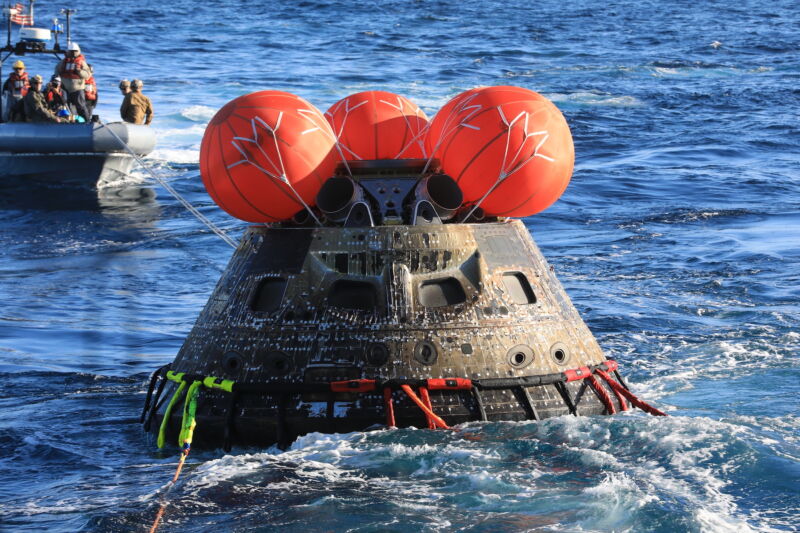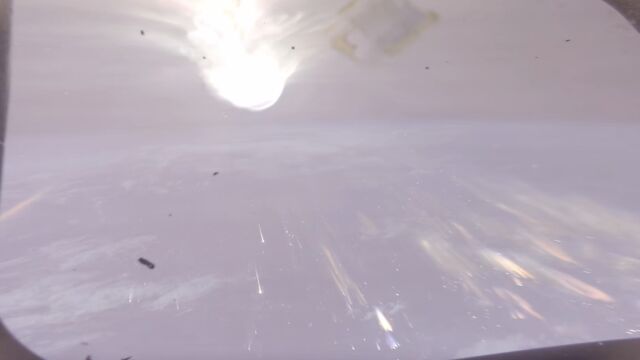
NASA has asked a panel of outside experts to review the agency's investigation into the unexpected loss of material from the heat shield of the Orion spacecraft on a test flight in 2022.
Chunks of charred material cracked and chipped away from Orion's heat shield during reentry at the end of the 25-day unpiloted Artemis I mission in December 2022. Engineers inspecting the capsule after the flight found more than 100 locations where the stresses of reentry stripped away pieces of the heat shield as temperatures built up to 5,000° Fahrenheit.
This was the most significant discovery on the Artemis I, an unpiloted test flight that took the Orion capsule around the Moon for the first time. The next mission in NASA's Artemis program, Artemis II, is scheduled for launch late next year on a test flight to send four astronauts around the far side of the Moon.
Another set of eyes
The heat shield, made of a material called Avcoat, is attached to the base of the Orion spacecraft in 186 blocks. Avcoat is designed to ablate, or erode, in a controlled manner during reentry. Instead, fragments fell off the heat shield that left cavities resembling potholes.
AdvertisementInvestigators are still looking for the root cause of the heat shield problem. Since the Artemis I mission, engineers conducted sub-scale tests of the Orion heat shield in wind tunnels and high-temperature arcjet facilities. NASA has recreated the phenomenon observed on Artemis I in these ground tests, according to Rachel Kraft, an agency spokesperson.
"The team is currently synthesizing results from a variety of tests and analyses that inform the leading theory for what caused the issues," said Rachel Kraft, a NASA spokesperson.
Last week, nearly a year and a half after the Artemis I flight, the public got its first look at the condition of the Orion heat shield with post-flight photos released in a report from NASA's inspector general. Cameras aboard the Orion capsule also recorded pieces of the heat shield breaking off the spacecraft during reentry.
NASA's inspector general said the char loss issue "creates a risk that the heat shield may not sufficiently protect the capsule’s systems and crew from the extreme heat of reentry on future missions."
"Those pictures, we've seen them since they were taken, but more importantly... we saw it," said Victor Glover, pilot of the Artemis II mission, in a recent interview with Ars. "More than any picture or report, I've seen that heat shield, and that really set the bit for how interested I was in the details."

Now, another team will examine the results of NASA's investigation.
"In late April, NASA chartered an independent review team which includes experts outside the agency to conduct an independent evaluation of the investigation results," Kraft said in a statement to Ars. "That review, scheduled to be complete this summer, ensures NASA properly understands this condition and has corrective actions in place for Artemis II and future missions."
Jim Free, NASA's associate administrator, told Aerospace America that this independent review team will be "another set of eyes" to look at the program. "We’ve had someone following us from an independent perspective who’s been very good at asking questions and saying, 'Hey, here’s some other theories.' Hopefully, the review team will finish the end of June," Free said.
Luis Saucedo, a NASA engineer at NASA's Johnson Space Center, leads the agency's internal char loss investigation. NASA did respond to a question from Ars about who is chairing the independent review team.
"We’ve really stepped into this in a careful manner. And frankly, it’s a flight test," Free told Aerospace America. "That’s what the first mission was, that’s what the second mission should be: another flight test. So we have to take that mindset for all of the issues. The heat shield was just the most prominent one."
A complicated problem
Among the four members of the Artemis II crew, Glover is the astronaut most closely following the heat shield investigation.
Advertisement“We’ve got a lot of folks involved that we trust," Glover said. "We’ve got the right people. If there is a solution, we’ll figure it out.”
But settling on a solution will only come after NASA determines what caused the Orion spacecraft's heat shield to perform the way it did. And there's no guarantee NASA will find a definitive root cause. While engineers have recreated the char loss on sections of Orion's heat shield in ground tests, they can't test the full 16.5-foot-diameter (5-meter) heat shield on the ground or replicate the exact material response or flight environment experienced on Artemis I.
"We have a lot of extrapolation for scale that we have to do," said Jeremy Vander Kam, deputy manager for Orion's heat shield at NASA's Ames Research Center, shortly after the Artemis I mission in 2022. "Similarly, our test facilities can't reach the combination of heat flux, pressure, shear stresses, etc., that an actual reentering spacecraft does. We're always having to wait for the flight test to get the final certification that our system is good to go."
Despite the shortcomings of ground tests, engineers have learned some things about Orion's heat shield.
"I think we have figured out some very important aspects of what creates these cracks, and what creates the force to remove the pieces that crack," Glover said. "I think we understand some of these mechanics."

A spacecraft like Orion returning to Earth from the Moon reenters the atmosphere about 40 percent faster than a spacecraft like SpaceX's Crew Dragon coming back from low-Earth orbit. So engineers are working with data from a single flight, Artemis I, as they assess the Orion heat shield.
Advertisement"We might get to the point where we realize there's some things that aren't knowable," Glover said. "There may be parts of this that we can't figure out on the ground or in wind tunnels."
Artemis II will fly a different path around the Moon than Artemis I. Instead of entering lunar orbit, Artemis II will loop around the back side of the Moon on a so-called free return trajectory. Glover and his three crewmates will be the first people to fly near the Moon since 1972, and depending on the exact flight path (which changes with each launch window), could travel farther from Earth than anyone in history.
After 10 days in space, the Artemis II astronauts will reenter the atmosphere to head for a parachute-assisted splashdown in the Pacific Ocean. Although the flight plan is different from Artemis I, the Orion spacecraft on Artemis II will still return to Earth at roughly the same blistering speed of 25,000 mph (40,000 km per hour). That would subject the heat shield to similar heat loads it saw on Artemis I.
"This is a very, very complicated thing," Glover said. "The heat flow alone is really complicated to understand—the physical dynamic forces of all that wind and plasma swirling around. Imagine looking at a raging river, a whitewater river, and trying to analyze just one spot. What's happening at that spot? Recreate it. Draw it. It's really complicated."
The first two Artemis test flights are precursors to eventual crew landings on the lunar surface. The Orion spacecraft and Space Launch System rocket are centerpieces of the program, providing transportation for astronauts to fly to the vicinity of the Moon and back to Earth.
What are the options?
Potential solutions to the heat shield issue for Artemis II include altering the spacecraft's trajectory during reentry or making changes to the heat shield itself. Another option could be to do nothing and fly the Artemis II mission as is. So far, there's been no open discussion from NASA officials about revamping the entire Artemis II flight plan to pursue other objectives that don't involve flying around the Moon.
The heat shield for Artemis II is already installed on the Orion spacecraft undergoing preflight testing at NASA's Kennedy Space Center in Florida. Modifying the heat shield now would require disassembling the Orion crew module from its European service module, probably delaying the Artemis II launch a year or more beyond its current target schedule in September 2025.
Heat shields for subsequent Orion spacecraft may also need to be redesigned in the aftermath of the char loss investigation.
On Artemis I, Orion flew a skip reentry profile, where it dipped into the atmosphere, skipped back into space, and then made a final descent into the atmosphere, sort of like a rock skipping across a pond. This profile allows Orion to make more precise splashdowns near recovery teams in the Pacific Ocean and reduces g-forces on the spacecraft and the crew riding inside. It also splits up the heat load on the spacecraft into two phases.

There are other reentry trajectories available for NASA to choose from.
"The types of entries that you can do are ballistic, where you kind of spin the vehicle to a constant rate," Glover said. "That's a very high g-load. It’s very hard on the crew, but it's a type of entry. Then, there's an entry that's called direct. It sounds more direct than it is. It's kind of a mini-skip. It's not as high of an elevation skip. And then there's the skip, where you almost have two entries. Those are the options."
AdvertisementEssentially, these different types of reentry trajectories have the Orion spacecraft fly through the atmosphere at different angles. With each trajectory, there is a different downrange distance from the point where the capsule first encounters the uppermost fringes of the atmosphere.
"You can modulate the range and can reduce the range, and that might reduce the energy imparted on the vehicle, on the heat shield, but you're still going to have impulse heating," Glover said. It's not just heat, though. There's physical force. It’s the friction that's creating that plasma field. So there's also a mechanical piece to this."
But altering the angle of Orion's reentry on Artemis II may not remedy the problem. Char material from the Artemis I heat shield started falling away from the spacecraft early in the reentry sequence.
“We saw liberation very early on Artemis I," Glover said. "If the damaging pieces start very early, there's no guarantee that changing the trajectory is the answer. It will change something, but it won't necessarily fix it. So we need to understand the root cause, if it's knowable."
With the conclusion of the char loss investigation, NASA managers will start building what they call flight rationale. Essentially, this is a process of convincing themselves the spacecraft is OK to fly, under certain conditions.
"We’ve begun to dip our toe in the flight rationale—how we do the skip. Do we do the skip? How could we fly the mission different?” Free said.
Changes to the reentry trajectory affect how quickly the heat shield heats up when it hits the atmosphere. But the peak temperatures are about the same for each trajectory option, Glover said.
"It could still be a skip entry. It could still be a direct entry," Glover said. "Ballistic would obviously be shorter (duration and range). There's about 4,000 miles of capability downrange, but we could reduce it and say we'll limit it only to 2,000 or 1,800 miles, and that would, therefore, affect what type of entry—direct or skip. How you fly the skip, where you put your lift vector, determines how high you peak and how far downrange you go.”



















